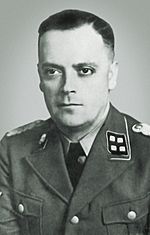Arthur Liebehenschel facts for kids
Quick facts for kids
Arthur Liebehenschel
|
|
|---|---|
 |
|
| Born | 25 November 1901 |
| Died | 24 January 1948 (aged 46) Montelupich Prison, Kraków, Polish People's Republic
|
| Cause of death | Execution by hanging |
| Criminal status | Executed |
| Children | 5 |
| Motive | Nazism |
| Conviction(s) | Crimes against humanity |
| Criminal penalty | Death |
| SS career | |
| Allegiance | |
| Service/ |
Death's Head Units |
| Years of service | 1934–1945 |
| Rank | SS Lieutenant colonel |
| Commands held | Auschwitz, 1 December 1943 – 8 May 1944 Majdanek, 19 May – 22 July 1944 |
Arthur Liebehenschel (German: [ˈaʁtuːɐ̯ ˈliːbəhɛnʃl̩]; 25 November 1901 – 24 January 1948) was a high-ranking officer in the SS, a powerful organization in Nazi Germany. He was a commandant at the Auschwitz and Majdanek concentration camps during a terrible time called the Holocaust. After World War II, he was found guilty of serious crimes against humanity by the Polish government. He was executed in 1948.
Contents
Arthur Liebehenschel's Life
Early Life and Joining the SS
Arthur Liebehenschel was born on November 25, 1901, in Posen, which is now Poznań, Poland. He studied subjects like business and how governments are run. He was too young to fight in World War I.
In 1919, he joined a group called the Freikorp "Grenzschutz Ost". Later, he served as a sergeant in the German army. In 1932, he became a member of the Nazi Party. Two years later, in 1934, he joined the SS. This was a very powerful and feared group in Nazi Germany.
Liebehenschel worked in the Death's Head Units within the SS. He became an assistant at the Lichtenburg concentration camp. After two years, he moved to Berlin to work for the office that oversaw all concentration camps. In 1942, he became a leader in the department that managed these camps.
Role as Camp Commandant
On December 1, 1943, Liebehenschel became the commandant of Auschwitz I concentration camp. He took over from Rudolf Höss. During his time, terrible acts continued at the camp. However, he made some small changes. For example, he stopped using "standing cells," which were tiny cells where prisoners had to stand for long periods. He also stopped some of the selections of regular prisoners for the gas chambers.
A prisoner named Hermann Langbein, who was in the Auschwitz hospital, noticed a change. He said that even some of the very cruel SS members became a bit less harsh. They realized their extreme actions might not be accepted anymore.
On May 8, 1944, Rudolf Höss returned to Auschwitz and replaced Liebehenschel. Liebehenschel then became the commandant of the Majdanek camp on May 19, 1944. This camp was already being emptied because the Soviet army was getting closer to German-occupied Poland. Liebehenschel then moved to Trieste, Italy, where he worked in an SS office.
After the War
After World War II ended, Arthur Liebehenschel was captured. He was put on trial by the Polish government for his actions during the war. He was found guilty of crimes against humanity. This means he was responsible for terrible acts against many people. He was executed in 1948.
His Family's Story
Arthur Liebehenschel had a son and three daughters with his first wife, Gertrud. His youngest daughter, Barbara Cherish, was born in 1943 and now lives in the United States.
In 2009, Barbara Cherish wrote a book called My Father, the Auschwitz Commandant. In her book, she described some of the small improvements her father made for prisoners. But she also talked about his role in the terrible system that caused so much suffering. In 2002, she and another daughter, Antje, were interviewed by a German TV channel. They spoke about what it was like to live with the knowledge of their father's actions. Liebehenschel also had a son with his second wife, Anneliese.
See also
 In Spanish: Arthur Liebehenschel para niños
In Spanish: Arthur Liebehenschel para niños

